Oversize Load Transport: Everything You Need to Know
Oversize and heavy-load transport requires more expertise, caution and regulatory knowledge than standard load transport. Environmental awareness in this field is also an important issue.
You don’t know if your load is considered oversized?
Wondering if heavy hauling is available in your industry?
You don’t know how to choose an oversize load transport company?
To help you make the best choices and get your cargo to its destination safely and on time, here are our top expert tips!
What is Oversize Load Transport?

Oversize load transport is regulated by the authority in each jurisdiction through which the vehicles pass. Specifics vary according to weight, length, height and many other details.
In general, an oversized load requires a higher level of planning than a traditional load because of the number of variables that come into play. For example, each jurisdiction has its own public safety and road condition considerations, as well as times of the year when there are size and weight restrictions.
How to know if your load is considered oversized?
There may be a thin line between standard heavy transport and oversize transport. In order to plan properly, it is important to know which measures will be applied or not in every situation.
Oversize Load Transport Regulations in Canada
Restrictions on heavy trucks in Canada are managed and enforced by the specific province through which they travel. It is therefore necessary to plan the optimal route according to the oversized loads carried and the permits on hand.
Generally in Canada, any road transport over 75′ 5” (23 m) long, 8′ 6″ (2.59 m) wide and 13′ 7″ (4.15 m) high is considered oversized. There is no gross weight rule imposed in Canada that indicates a specific limit on the vehicle before considering oversized.
Once loads begin to exceed a certain size threshold, a province or one of its municipalities may impose the need to travel with an escort vehicle.
For precise regulations by province, contact one of our oversize load transport experts.
U.S. Oversize Load Transport Regulations
As in Canada, the size and weight restrictions for a heavy haul depend on the corresponding state legislation and the specific section of highway on which the oversized load travels in the United States.
In general, loads that are greater than 75′ 5” (23 m) long, 8′ 6″ (2.59 m) wide and 13′ 6″ (4.11 m) high is considered oversized trailers in the U.S., however a 53’ (16.15 m) trailer is accepted as legal and the gross weight limit, it is generally 80,000 lbs.
For precise regulations by state, contact one of our oversize load transport experts.
Oversized transport solutions tailored to various industries
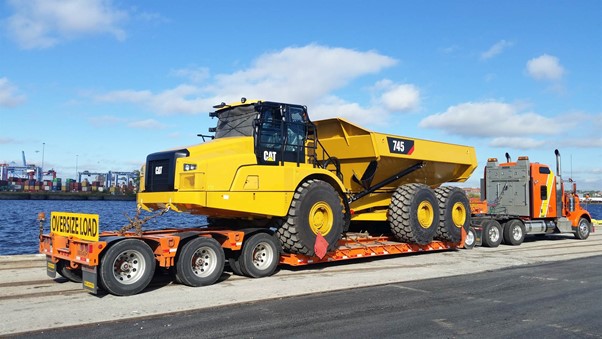
Many types of equipment and loads are eligible for oversize load transport. The terms “oversize load” and “oversized load” have nothing to do with the type of load and everything to do with its dimensions. Equipment that typically falls into the oversize category includes:
Building Equipment: cranes, dump trucks, excavators and bulldozers
Building Materials: steel beams and piping
Agricultural Equipment: harvester threshers and tractors
Manufacturing Equipment: assembly lines, conveyors and crushers
Housing: mobile and prefabricated homes
To give you an idea of the main industries served by oversized transport (and its applications), here are the sectors in which we regularly operate at Groupe Bellemare.
- Transport, loading, and unloading of wind turbines blades, towers, and nacelles, requiring extendable and modular trailers.
- Convoys with escorts and carefully planned routes based on height and width restrictions.
- Logistical challenges related to remote sitews and access via unconventional roads.
- Transport of machinery, crusher parts, conveyor galleries, excavators, articulated dump trucks, and more.
- Logistics adapted to hard-to-reach locations and rugged terrain requiring complex maneuvers.
- Transport of turbines, transformers, generators, electrical switchgear, alternators, and other oversized components for hydroelectric dams, power plants, natural gas companies, refineries, and more across North America.
- Specialized handling for loading and unloading large and fragile equipment.
- Coordination with authorities for temporary road closures when transporting oversized parts.
- Transport of steel structures, tanks, and plant equipment.
- Use of cranes and specialized lifting systems for handling.
- Strategic planning to minimize impact on industrial operations and traffic.
- Management of permits, customs clearance, and other required procedures.
- Transport of excavators, wheel loaders, graders, bulldozers, and other heavy machinery from across North America.
- Compliance with weight and safety regulations for long-distance transport of heavy loads.
- Transport of beams, pillars, and other structural components.
- Carefully planned routes to avoid height and weight constraints on existing infrastructure.
- Coordination with municipalities and transportation services to ensure safe traffic management.
- Transport of railcars, locomotives, and specialized railway components.
- Customized loading and unloading solutions for heavy and oversized pieces.
- Close collaboration with railway industry stakeholders to ensure safe and efficient logistics.
What to consider when choosing the best oversize load transport company?

Rates are important, but experience and safety are the main criteria to choose which transport company will be responsible for your oversize load. We recommend that you consider the following factors:
Awards in safety, performance, environmental awareness and customer service quality?
These types of distinctions make it much easier to trust a company. You will know that your shipment is in good hands and have peace of mind!
Are the customer reviews positive?
Some companies are good at speaking well of themselves. However, customer reviews don’t lie and allow you to see real testimonials of experiences with the company. Are they on time? Do the shipments arrive at their destination in good condition? Does the company use optimal routes? You can also contact customers directly with your questions.
Does the company have the right trailer for your needs? How to choose the right equipment?
It is important to be aware of the equipment choices available. Does the company have a sufficient fleet to meet your unique needs? Here is an example of the type of technical equipment offered by Transport Bellemare:

To find out each trailer characteristics and which one is best suited to your situation, contact one of our experts!
Proven Company Expertise and Knowledge
These aspects can be assessed when you visit the company’s website and when you first contact them. Do they adequately answer your questions? Does the company demonstrate its expertise by raising important issues related to regulations and permits? Ask several questions to ensure that the company is meeting your expectations.
Does pricing respect your transport budget?
Of course, pricing is also part of the equation. This can be an important factor if you are deciding between two similar transport companies that both meet your needs!
Examples of Our Achievements
Here are a few major projects that have been successfully completed by our team, as well as the type of equipment used and the cargo transported.
Gaz Métro Tanks
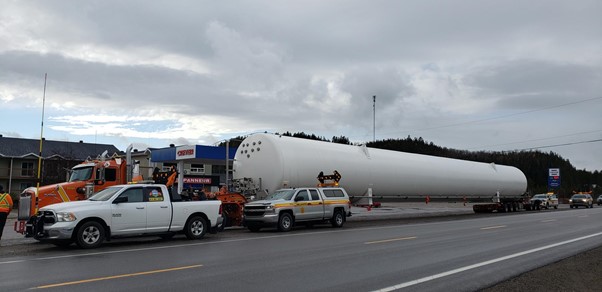
Cargo: Three 135 feet-long (41.15 m) liquefied natural gas (LNG) tanks from New Prague, MN to Sept-Iles. The tanks measure 132’5” (40.36 m) × 12’78” (3.84 m) × 12’9” (3.91 m) and weigh 155 602 lb. This long journey was punctuated by traffic circles: 4 in total!
Equipment Type: “Directional Dolly”

Highlights:
- This contract started in March and ended in October. Numerous negotiations had to be made with the MTQ, as no convoy this long had taken place on route 138 further than Baie-Comeau in the recent past.
- Once on the trailer, we get a total load of 185 ft long, 12 ft wide and 15 ft high.
Wind Turbine

Cargo: Wind Turbine (including blades and towers)
Equipment Type: Expandable trailer for windmill blades (for the blades) and dual trailer (“schnable” with steerable “dolly”) (for the towers).


Highlights: Project carried out over several months in collaboration with our Hauling Sector. Bellemare Heavy Haul & Rigging took care of moving the parts from Marmen’s Matane facility to the port using multi-lines. They were moved by boat from the port of Matane to La Baie (Grande-Anse), and then transported by Transport Bellemare from Grande-Anse to Saint-Gédéon for the Belle-Rivière wind farm.
REM Trains
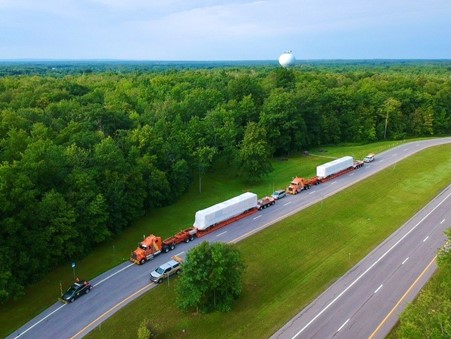
Cargo: Trains for the new Greater Montreal REM (Réseau express métropolitain)
Equipment Type: Train Directional Trailer (integrated tracks)

Highlights: We have delivered approximately 33% of the trains to date. Since tracks are integrated to the trailer, trains are loaded onto the trailer and unloaded directly onto REM tracks.
A 13-Axle Trip
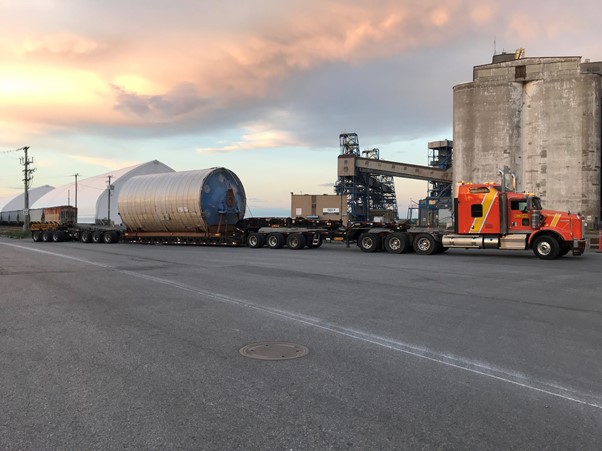
Cargo: A huge piece used in the paper-making process for the WestRock mill in La Tuque
Equipment Type: 13-axle trailer
Highlights: The Trois-Rivières to La Tuque trip took two days and required the intervention of public utility (Bell, Videotron, Hydro-Québec, etc.) to shift wires during convoy movement.
Our Experience in the Field
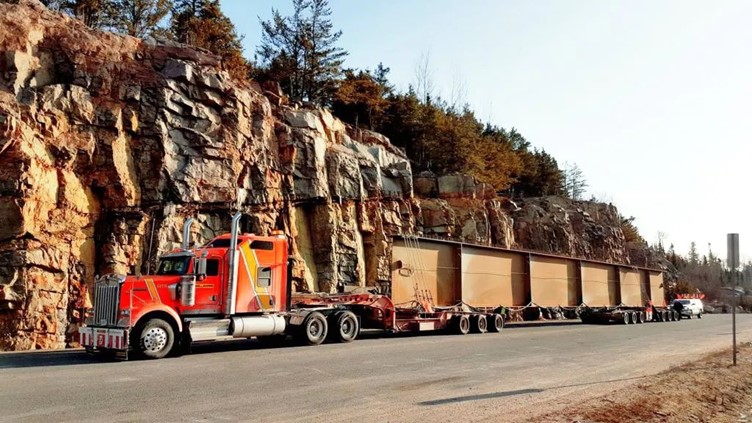
At Transport Bellemare, we have been transporting goods and heavy equipment since 1982! In addition to this experience, we have prestigious certifications, a fleet of varied, efficient and safe transport trucks, a solid ecological conscience and a personalized customer service.
To ask us a question or to take advantage of the expertise that has enabled us to carry out several large-scale projects throughout North America, contact one of our experts on oversize load transport.
